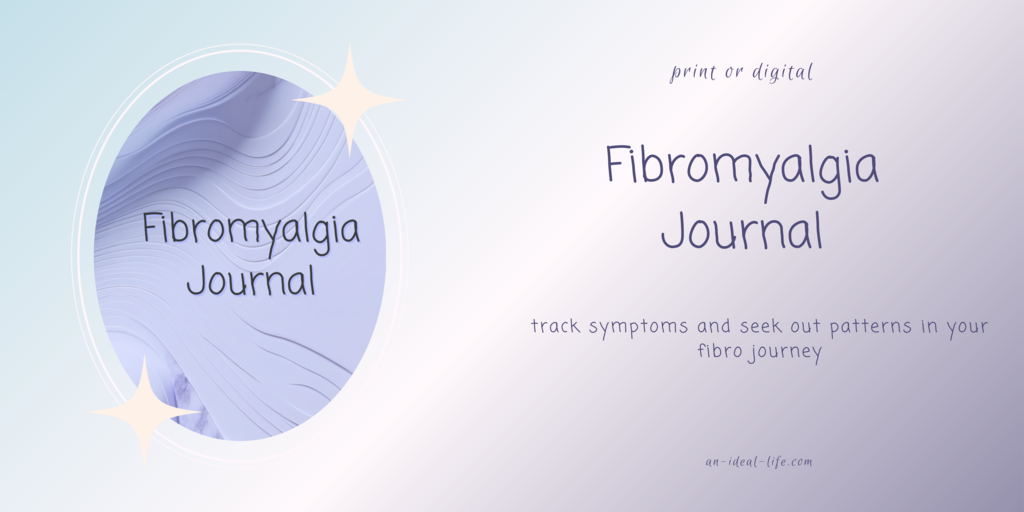Living with chronic illness often means managing a delicate balance between physical symptoms, emotional well-being, and day-to-day life demands. While medical care is essential, developing self-care practices, and day-to-day life demands. While medical care is essential, developing self-care practices that nurture the mind and spirit is equally important. One powerful tool is a guided journal designed to specifically support you in navigating the complexities of chronic illness. So why use a guided journal for chronic illness?
*This post may include affiliate or referral links. At no extra cost to you (and with a special reader discount, in some cases!), I’ll receive a small commission or other rewards to help support An Ideal Life. As an Amazon Associate, I earn from qualifying purchases*
The information in this blog post is provided for educational and informational purposes only and should not be construed as medical advice. The content is not intended to be a substitute for professional medical advice, diagnosis, or treatment. Always seek the advice of your physician or other qualified healthcare provider with any questions you may have regarding a medical condition. Never disregard professional medical advice or delay seeking it because of something you have read online. The author of this post is not a licensed medical professional and does not assume any liability for any actions taken based on the information contained in this post.
Unlike blank notebooks, guided journals provide structure through tailored prompts and exercises, helping users delve deeper into their thoughts, emotions, and health patterns. This practice offers benefits far beyond what’s written, acting as a transformative part of the chronic illness experience.
The Benefits of Guided Journaling for Chronic Illness
Guided journalling goes beyond the blank page by offering prompts, exercises, and reflections tailored to help spoonies explore their experiences with chronic illness in a meaningful and constructive way. This structure, combined with the therapeutic nature of writing, can lead to profound insights and long-term benefits that extend into various aspects of life with chronic illness.
Tracking Physical Symptoms and Patterns Over Time
One of the most practical uses of a guided journal for chronic illness is its ability to help track symptoms and identify patterns. Chronic illnesses often come with fluctuating symptoms that can be difficult to recall accurately over time. Guided journals can prompt you to document your physical state, pain levels, and any triggers you observe. Over time, these entries reveal trends, such as how certain foods, stress levels, or activities correlate with symptom severity.
By documenting these details consistently, individuals create a comprehensive record that can be invaluable for medical appointments. This data-driven approach not only empowers patients to advocate for themselves in medical settings but also offers healthcare providers clear, concrete information to guide more personalized and effective treatment plans.
Blog Post: Dealing With Dismissive Doctors and Medical Gaslighting
Exploring and Validating Emotional Health
Many of us living with chronic conditions experience a wide range of emotions, from anger and sadness to fear and anxiety. A guided journal for chronic illness offers a safe space to explore these feelings, providing prompts that encourage emotional honesty and validation.
This practice helps process complex feelings that may otherwise be difficult to express. Writing becomes an act of self-compassion—a way to acknowledge pain, fear, and frustration without minimizing your experience. Over time, this habit fosters greater emotional resilience and sense of self, creating a degree of stability amidst the uncertainty of life with chronic illness.
Creating Consistent Self-Care Rituals
For those of us managing chronic illness, maintaining consistent self-care routines can be transformative. At the same time, though, it’s easy to become overwhelmed or feel guilty for prioritizing self-care when there are so many competing demands.
A guided journal for chronic illness may provide prompts that emphasize small, achievable acts of care. These exercises normalize and validate the importance of self-care, encouraging you to build rituals that sustain your physical and emotional well-being. By focusing on simple, manageable actions, the journal can help you build habits that feel accessible and rewarding, rather than burdensome.
Building Resilience Through Cognitive Reframing
Chronic illness often brings up negative thought patterns, especially when facing physical limitations or setbacks. Guided journals can offer prompts that focus on cognitive reframing—a technique used in therapy to shift negative thinking patterns into more constructive and compassionate ones.
This doesn’t mean ignoring pain or pretending everything is fine. Instead, it’s about acknowledging difficulties while finding ways to cultivate optimism and hope, even in small ways. By practicing cognitive reframing consistently, you can build mental strength and a toolkit of strategies you can use during difficult times.
Setting Meaningful Goals and Celebrating Progress
Living with chronic illness doesn’t have to mean putting life goals on hold. A guided journal for chronic illness can provide a space to set meaningful, realistic goals that align with your health and abilities. Whether it’s aiming to incorporate a five-minute meditation into the day, gradually increasing physical activity levels, or focusing on mental health exercises, journaling helps break down these goals into achievable steps.
The simple act of recording and reflecting on progress allows us to celebrate even the smallest victories. Journaling helps transform these moments into milestones, shifting our focus from limitations to achievements. Over time, this practice can build confidence, helping us see that our lives are still full of potential and possibility, even with health challenges.
Creating a Personal Narrative of Healing and Growth
A guided journal for chronic illness can chronicle your journey over time, tracking the highs and lows, moments of strength and vulnerability, and instances of resilience to build a powerful narrative of healing and growth. This can help remind you of the resilience you’ve shown and the ways you’ve adapted, leaned, and thrived.
Over time, your entries become a resource to look back on, revealing just how far you’ve come. From the smallest triumphs to the courage to face difficult days, a guided journal for chronic illness will capture these moments, offering a sense of continuity and empowerment.
The Science Behind Journaling for Chronic Illness
Studies show that expressive writing and journaling can positively impact both physic and mental health, making it an especially useful tool for those of us living with chronic conditions.
Reducing Stress
Research indicates that journaling can help reduce stress levels by allowing individuals to process and express their emotions. This is another reason to use a guided journal for chronic illness, as stress can exacerbate symptoms. Journaling provides a safe space to explore difficult emotions, helping reduce stress and anxiousness.
Supporting Immune Function
Believe it or not, journaling can even influence physical health outcomes! When we write about emotionally significant events, it may reduce the overall stress load on the body, allowing for improved immune system performance. For those of us with illnesses which impact or are impacted by immune function, a guided journal for chronic illness may serve as a complementary tool for health management.
Enhancing Cognitive Function and Memory
Journaling may also help to improve cognitive functioning. By organizing your thoughts on paper, you can create a coherent narrative of your experiences, which has been linked to improved memory and cognitive processing. This is especially beneficial for those of us managing conditions that may affect concentration or memory, providing a method for tracking experiences and maintaining mental clarity.
Making Journaling Accessible
For those of us managing chronic illnesses, finding the energy and motivation to journal regularly can be challenging. That’s why it’s essential to adapt the practice to fit different needs, offering more sustainable benefits.
Adapting Journaling Techniques
Accessibility is key! Here are a few ways to make a guided journal for chronic illness fit different energy levels or physical abilities:
- Voice-to-Text Journaling: For those with limited energy or physical mobility, voice-to-text apps can be a great way to document thoughts without having to write manually. Speaking your thoughts aloud can be just as effective and allows for flexibility in different environments.
- Digital Journals and Apps: Digital journaling platforms may offer accessibility features such as larger text options, audio entries, and organization tools. These features make it easier to maintain a journal without the need for physical writing.
- Short-Form Entries: Journaling doesn’t have to be time-consuming! Short entries or bullet journaling can keep the practice manageable on low-energy days.
Creating a Flexible Routine
Establishing a routine that aligns with your energy levels and symptoms is crucial. Rather than forcing a daily commitment, consider:
- Set Intentions Instead of Rigid Goals: For example, aim to journal a few times a week or when our symptoms feel intense. This approach reduces pressure and emphasizes flexibility.
- Designating Low-Energy Journal Practices: Have options for journaling that work on both high and low-energy days, such as using brief bullet points, drawing instead of writing, or using a journal app that allows for quick entries.
Incorporating Other Wellness Strategies
A guided journal for chronic illness can also integrate other self-care practices and wellness practices, creating a holistic toolkit for chronic illness management.
Mindfulness and Meditation
Your journal can include prompts that encourage you to describe your current sensations, focus on your breath, or reflect on the present moment. Adding mindfulness exercises can help you ground yourself, even in moments of discomfort.
Prompts might include:
- What are three things you notice around you right now?
- Take three deep breaths and describe how you feel afterward.
Gratitude and Affirmation Exercises
Gratitude journaling is a simple yet powerful practice shown to enhance well-being and mood. Guided journals might include prompts like:
- What are three things you’re grateful for today?
- Write down one affirmation that supports your health journey.
Physical Care
A guided journal for chronic illness can also complement physical self-care routines like yoga, physical therapy, or movement exercises. Journals might include space for tracking progress, noting which activities help alleviate symptoms or boost energy, creating an integrated approach that supports both body and mind.
Using a Guided Journal for Chronic Illness
The benefits of a guided journal for chronic illness are clear, but starting and maintaining your practice is where many people struggle. With that in mind, here are a few steps to make the process easier and more rewarding:
1. Choosing the Right Journal
Finding the right format is the first step. Some may prefer the tactile experience of a physical journal, while others might opt for a digital option that’s accessible anywhere. Choose a journal that aligns with your personal preferences!
2. Establishing a Journaling Space
Creating an environment that feels comfortable and calming can make a difference. A dedicated journaling space—whether that’s a cozy corner, a spot by a window, or even an outdoor area—can help signal that it’s time to reflect. Pairing this space with a cup of tea, soft lighting, or relaxing music can make journaling feel like a self-care ritual rather than a task.
3. Starting Small and Building Consistency
For those new to journaling, it’s best to start simply. Committing to just five minutes of journaling a few times a week, for example, can be a manageable entry point. Over time, as the practice becomes familiar, you can expand your entries and explore deeper reflections. The goal is to build a habit that feels sustainable, not overwhelming.
4. Using Prompts to Overcome Writer’s Block
Sometimes, knowing where to start is the hardest part! That’s the beauty of a guided journal for chronic illness. Using prompts designed for spoonies provides an easy entry point and removes the pressure of coming up with something to write about.
By integrating these strategies, beginning to use a guided journal for chronic illness can be a sustainable and enriching practice that supports the mind, body, and spirit, offering moments fo peace and clarity amidst the complexities of life with chronic illness.



